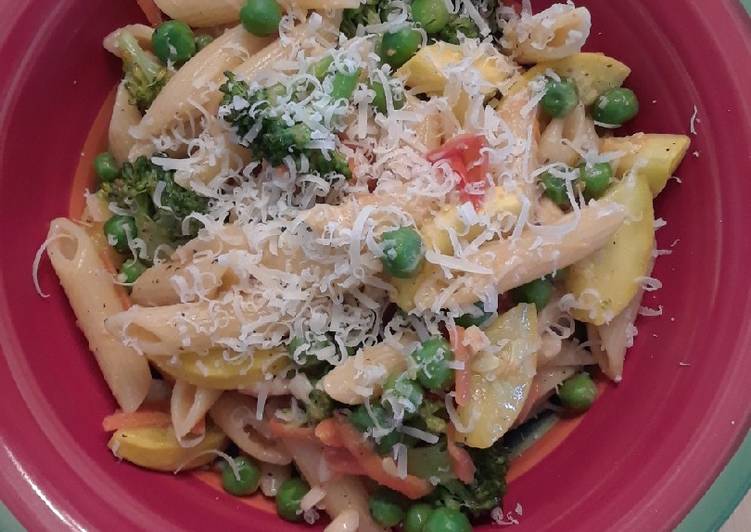Pasta Primavera. Fresh mushrooms cooked with onions and bacon add savory appeal to piping hot pasta tossed with eggs, cream and Parmesan. The heat of the pasta cooks the eggs, and a sprinkling of parsley and pepper flakes finishes the dish. Pasta primavera is a simple dish made with pasta and fresh vegetables.
 Pasta Primavera is a classic Italian American recipe that's loaded with spring vegetables.
It has a light and fresh sauce and is the perfect break from heavier winter foods!
Pasta Primavera A classic dish using a mixture of pasta, bright green al dente vegetables, and a flavorful sauce.
You can cook Pasta Primavera using 11 ingredients and 4 steps. Here is how you achieve that.
Pasta Primavera is a classic Italian American recipe that's loaded with spring vegetables.
It has a light and fresh sauce and is the perfect break from heavier winter foods!
Pasta Primavera A classic dish using a mixture of pasta, bright green al dente vegetables, and a flavorful sauce.
You can cook Pasta Primavera using 11 ingredients and 4 steps. Here is how you achieve that.
Ingredients of Pasta Primavera
- It's 3 tbsp. of salted butter, divided.
- Prepare of About 2 cups chopped veggies (see step 1 for more details).
- You need 3 cloves of garlic, minced.
- You need 2 cups of penne pasta, uncooked.
- Prepare of Salt and pepper.
- You need 1/4 tsp. of Italian seasoning.
- Prepare 1/4 tsp. of salt free all purpose seasoning.
- It's of Zest of 1 large lemon.
- Prepare of Juice of half large lemon.
- Prepare 1/2 cup of reserved starchy pasta water.
- It's 1/4 cup of freshly grated parmesan cheese + more for topping.
The key lies more in the method than the ingredients; indeed, using your own personal blend of favorite veggies is part of the fun of this dish. Primavera is Italian for "spring," and dishes titled "à la primavera" usually contain fresh vegetables. Pasta primavera is the most popular dish in the primavera family. Take advantage of the precut vegetables in your supermarket's produce section.
Pasta Primavera instructions
- For this recipe, it's pretty versatile, so use whatever veggies you have on hand, just be sure to chop them all to roughly even pieces. Pictured up top, I used yellow squash, broccoli florets, shredded carrots, sliced cherry tomatoes, green onions and peas...just to give an idea. This is a great chance to clean out the veggie drawer..
- Heat a large pot of salted water over high heat. Once it comes to a boil, cook the penne pasta according to the box directions until it is al dente. Before draining the pasta, reserve about 1/2 cup of the starchy water and set it aside, then drain the pasta and return it to the empty pot. While you're waiting on the water to boil, begin to cook the veggies, that way everything should be finished at roughly the same time..
- In a large skillet, heat 1 tbsp. of the butter over medium heat. If you have some heartier veggies, add them to the skillet first (I added my broccoli florets and yellow squash first, to give them a head start), then add more delicate veggies after the heartier ones have had a few minutes to soften up a bit. Once all the veggies are relatively crisp-tender, add in the garlic and season it all with the Italian seasoning, all purpose seasoning and about 1/4 tsp. each of salt and pepper..
- Once the veggies are ready, toss them into the pot with the cooked pasta, then top with the remaining butter, lemon zest, lemon juice and grated parmesan. Stir it all together, then drizzle in the reserved pasta water a bit at a time, until the pasta is at a good consistency (I usually end up using closer to 1/4 cup). Taste and season with some more salt and pepper, to taste. Then serve with some additional freshly grated parmesan cheese over the top..
We also find that a better way to serve pasta primavera means swapping the traditional strands of angel hair pasta for a short pasta, such as penne rigate, fusilli, or orecchiette. The long strands of angel hair are incompatible with chunky bites of vegetables, while the short shapes mimic the size of the trimmed vegetables and cook in just. The heat of the pasta cooks the eggs, and a sprinkling of parsley and pepper flakes finishes the dish. Marinated artichokes, tomatoes, and capers make a quick and easy sauce for fresh shrimp. Served with whole-wheat pasta and tangy goat cheese, this pasta dish is a deliciously.